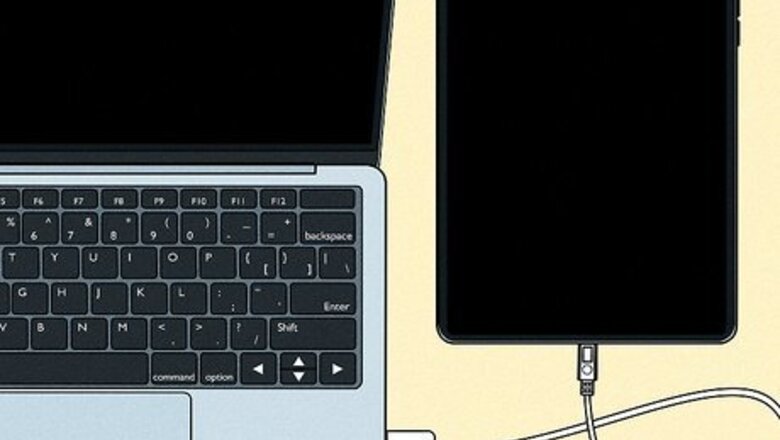
views
- You can connect your iPad to your PC or Mac with a USB cable and transfer files from Finder or iTunes.
- You can also transfer files using cloud storage services like iCloud, OneDrive, and Google Drive.
- If you're using a Mac, you can send files to your iPad wirelessly using AirDrop.
Finder (Mac)
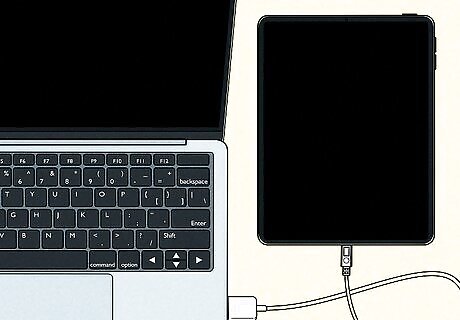
Connect your iPad to your computer. Plug one end of your iPad's charging cable into one of the computer's USB ports, then plug the other end into your iPad's charging port. If you have a more recent iPad, like the iPad 11 Pro, you may have a USB-C to USB-C cord instead. If your computer doesn't have a USB-C port, you will need to get either a USB-C to USB-A adapter or a USB-C to USB-A cable. Ensure the cable is a data cable. Otherwise, it may not work to transfer files. As of macOS Catalina and later, you must use the Finder to move files between your computer and your iPad. If your Mac is on an OS prior to Catalina, you can use the iTunes method.
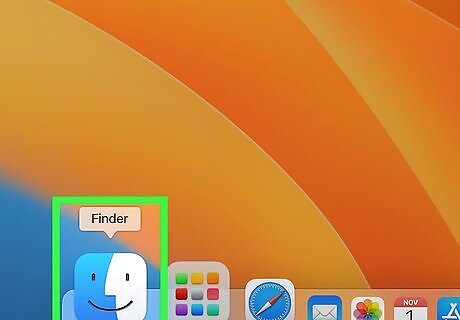
Open a Finder window. Finder is a half-blue, half-white icon with a smiling face, and is on your dock by default. It's the Mac equivalent of File Explorer on Windows.
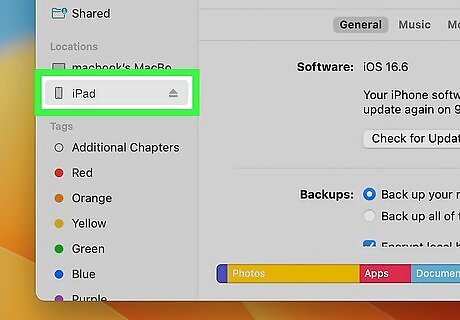
Check to ensure your device is in the sidebar. If your computer recognizes your device, it will be in the sidebar under "Locations." If your computer doesn't recognize your device, you may want to try a different USB port, restarting your devices, or trying a different cable.
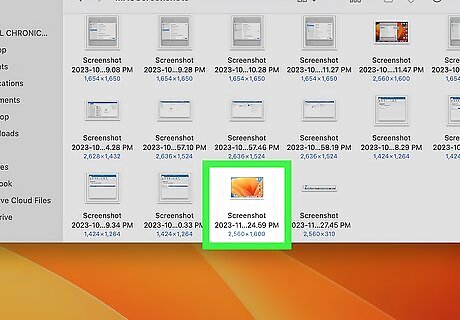
Navigate to the file you want to transfer. You can use the same Finder window to do this step.

Drag the files into an app folder on your device. If you're trying to transfer a file that doesn't fit into any particular app, you can add it to the Files app folder.
iTunes (Windows)
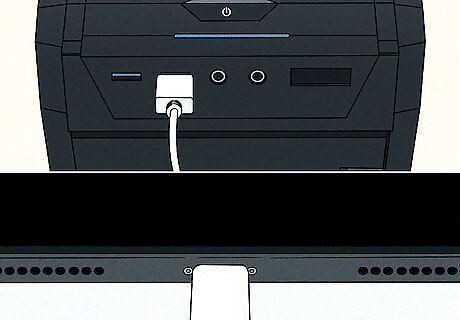
Connect your iPad to your computer. Plug one end of your iPad's charging cable into one of the computer's USB ports, then plug the other end into your iPad's charging port. If you have a more recent iPad, like the iPad 11 Pro, you may have a USB-C to USB-C cord instead. If your computer doesn't have a USB-C port, you will need to get either a USB-C to USB-A adapter or a USB-C to USB-A cable. Ensure the cable is a data cable. Otherwise, it may not work to transfer files. As of macOS Catalina and later, you must use the Finder to move files between your computer and your iPad. If your Mac is on an OS prior to Catalina, you can use the iTunes method.
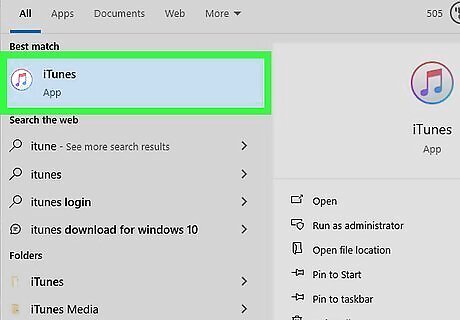
Open iTunes on your computer. Its app icon resembles a multicolored musical note on a white background. If iTunes prompts you to update it, click Download iTunes on the prompt and then restart your computer after the update completes.
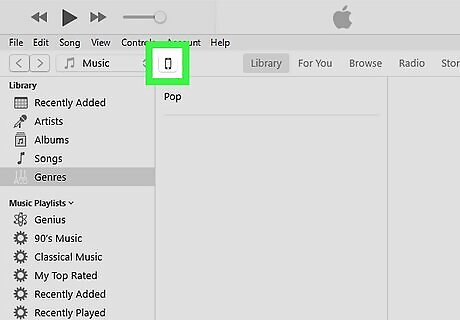
Click the "Device" icon. It's an iPad-shaped button on the upper-left side of the window. This will take you to your iPad's page.
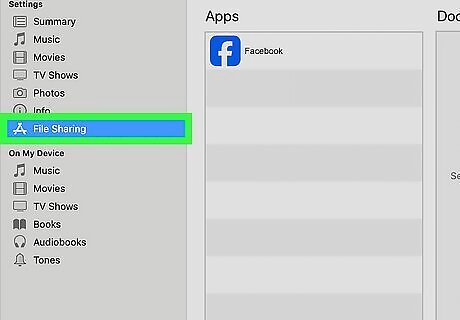
Click File Sharing. When you click the file "Device" icon in the upper-left corner, you can see the "File Sharing" option in the sidebar to the left. It's next to an icon "A."

Select an app. In the column of apps in the middle of the window, click an app to which you want to add a file. The file type doesn't necessarily have to correspond to the app (for example, you could add a Microsoft Word file to the iMovie folder). If you're trying to transfer a file that doesn't fit into any particular app, you can add it to the Files app folder.
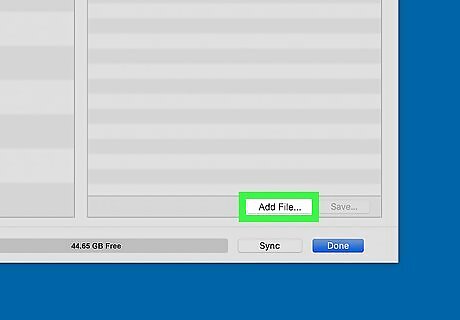
Scroll down and click Add File…. This button is on the lower-right side of the page. Doing so will open your computer's File Explorer.

Select a file. Click the file that you want to add to your iPad to select it. You may first have to go to the file's folder location by clicking the appropriate folder on the left side of the window.
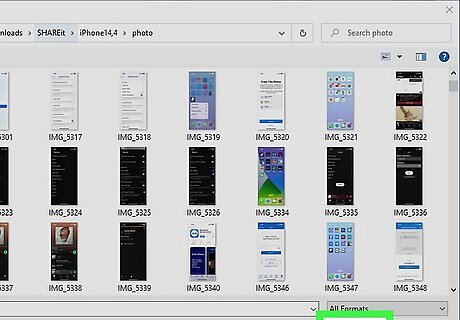
Click Open. It's in the bottom-right corner of the window. You should see the file's name appear in the app's window in iTunes.
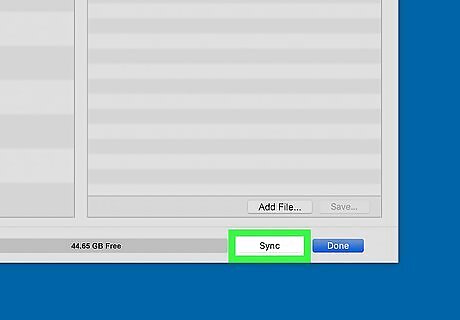
Click Sync. This button is on the lower-right side of the iTunes window. Doing so will add the file to your selected app on the iPad. At this point, you can open the file on your iPad at any time, even if you aren't connected to the Internet. You can click Done after the sync completes to return to the main page.
iCloud Drive
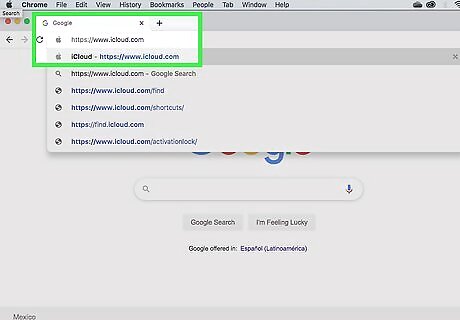
Go to https://www.icloud.com/ in your browser. This will open the iCloud login page. This is probably the easiest and fastest way to transfer files to and from your iPad from your Windows 10 computer.
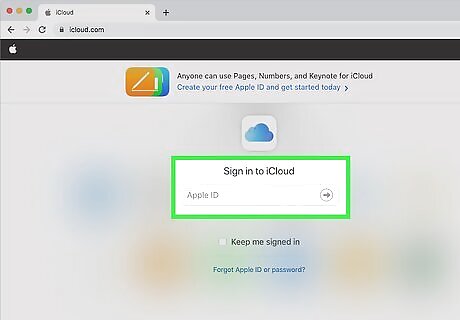
Log into your iCloud account. Enter your Apple ID email address and password, then click the arrow icon to the right of the Apple ID and password bars. Skip this step if you're already logged into iCloud. If you have two-factor authentication enabled, you'll need to get the 6-digit number from your iPad to log in on your computer. If you are asked if you want to trust the device you are logging into, tap Trust on both your iPad and computer.

Click iCloud Drive iPhone iCloud Drive Icon. It's a blue app with white clouds on it. Doing so opens your iCloud Drive page.
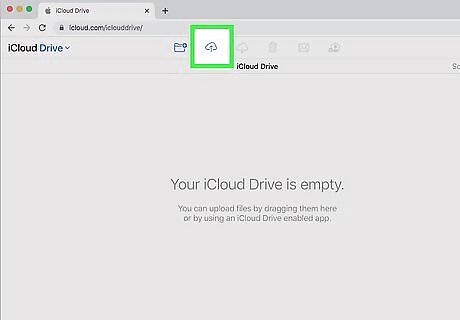
Click the "Upload" icon. It's at the top of the page. The icon resembles a cloud with an arrow pointing up. Doing so will open a File Explorer (Windows) or Finder (Mac) window.
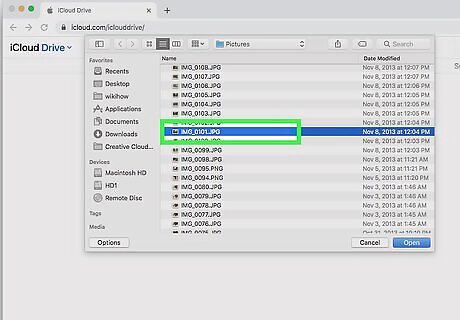
Click the file that you want to upload to iCloud Drive. Use the file browser to navigate to the files you want to upload. Click a file to select it. You can also select all files in a given location by clicking one file and then pressing Ctrl+A (Windows) or ⌘ Command+A (Mac). To select open multiple files, hold down Ctrl (Windows) or ⌘ Command (Mac) while clicking each file you want to select
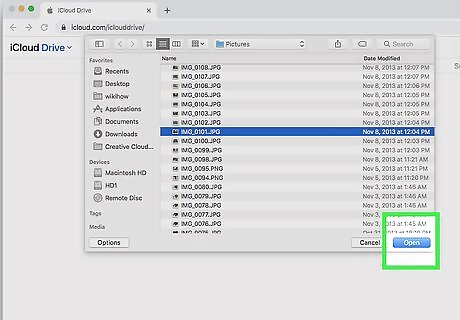
Click Open. It's in the bottom-right corner of the window. Doing so will prompt your files to begin uploading to iCloud Drive.
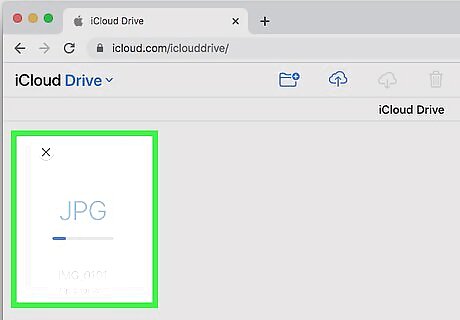
Wait for your files to upload. Depending on your files' combined size, this can take anywhere from a few seconds to a few hours. Once the files finish uploading, you can proceed.
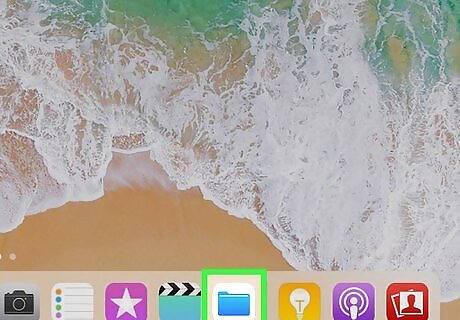
Open your iPad's Files app iPhone Files App. This app resembles a blue folder on a white background. The iCloud Drive app was replaced with Files in iOS 11, so this is where you'll go to download the iCloud files onto your iPad.
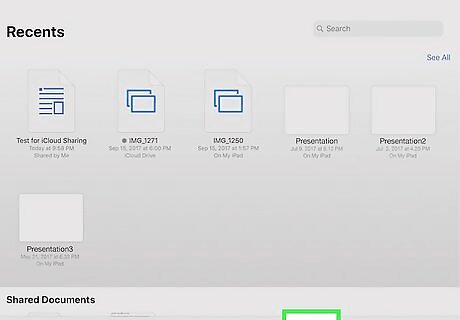
Tap the Browse tab. It's in the bottom-right corner of the screen.
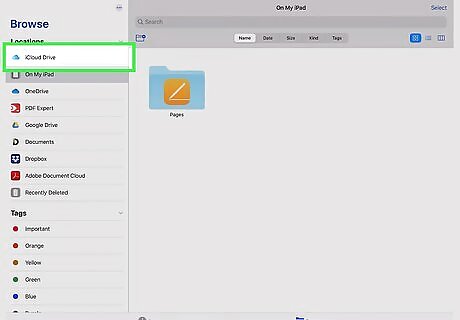
Tap iPhone iCloud Drive Icon iCloud Drive. You'll see this below the "Locations" heading. Doing so will open your iCloud Drive's contents. If you don't see this option, tap the Locations heading to prompt it to appear.
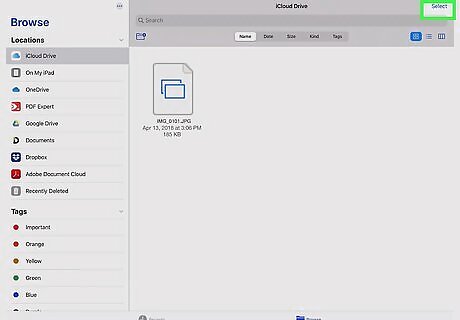
Tap Select in the top-right corner of the screen. This displays a blank circle next to each file.
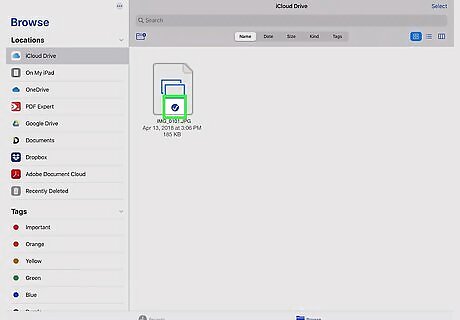
Tap each file that you want to move onto your iPad. This displays a checkmark in the circle next to each file you tap.
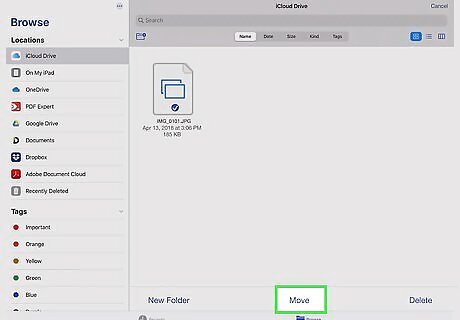
Tap the Move. You'll find this at the bottom of the screen.
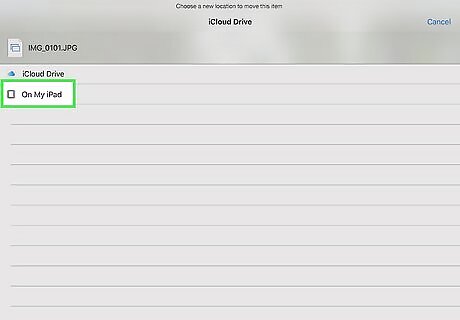
Tap On My iPad. It's next to an icon that resembles an iPad. This displays a list of folders on your iPad

Tap a folder you want to save your files to.
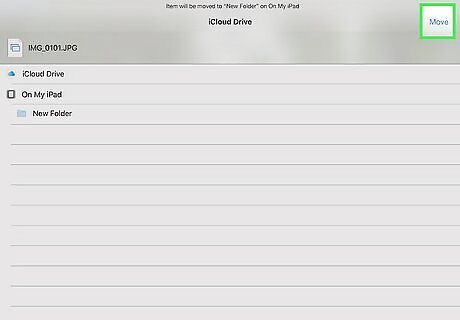
Tap Move. It's in the top-right corner of the screen. Doing so will add the selected files to your selected folder, making them available on your iPad even when you aren't connected to the Internet. You can open the files from within the Files app.
AirDrop
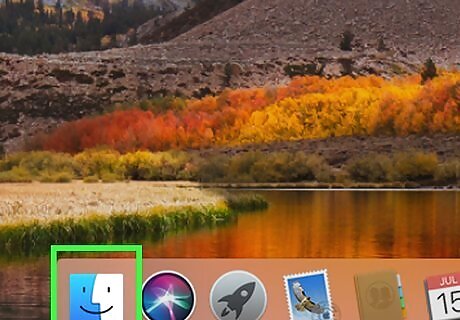
Open the Finder Mac Finder on Mac. It's the icon that resembles a blue and white smiley face.
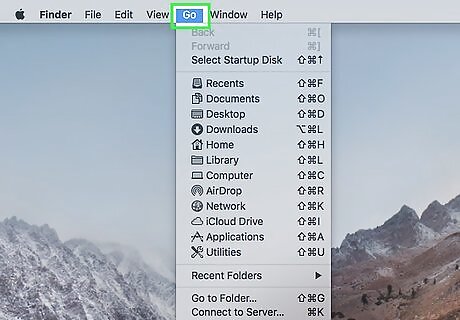
Click Go. It's in the menu bar at the top of the screen. This displays a drop-down menu of different common folders in the Finder.
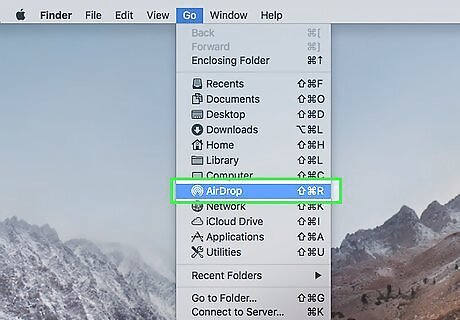
Click AirDrop. It's in the drop-down menu below "Go" in the Finder.
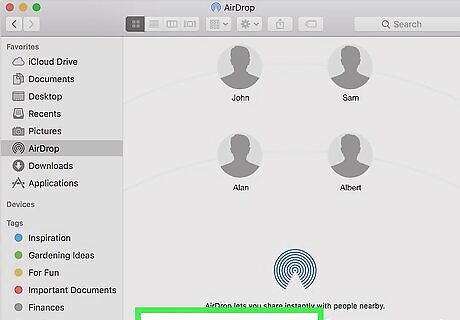
Select Contacts only or Everyone in the drop-down menu. The drop-down menu is at the bottom of the screen next to "Allow me to be discovered by:" This makes you discoverable through AirDrop.
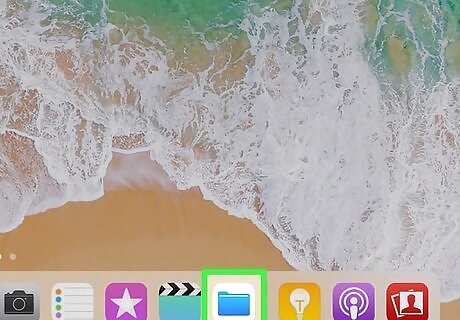
Open Files app iPhone Files App on your iPhone or iPad. It's in the app that resembles a blue folder in the Dock at the bottom of your home screen.
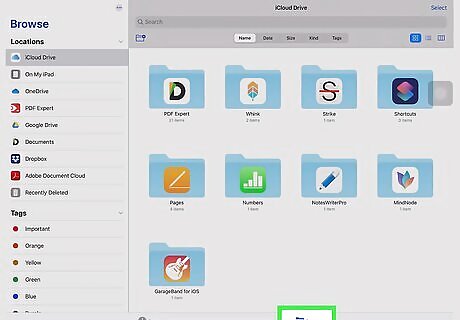
Tap Browse. It's the second tab at the bottom of the Files app. This displays a sidebar menu to the left.
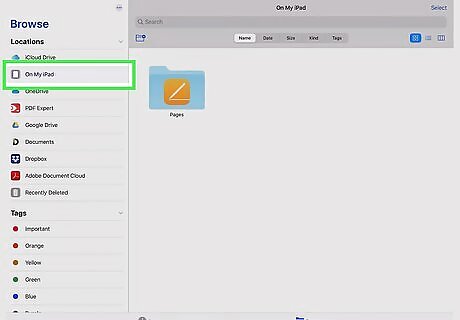
Tap On My iPad. It's next to an icon that resembles an iPad in the menu to the left.
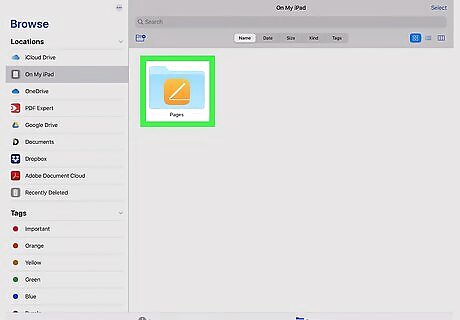
Tap the program that has files you want to transfer. Program files in the Files app are organized by app. Tap the app folder that corresponds to the files you want to transfer. This displays all the files for that app. For example, if you want to transfer some Pages documents to the app, tap Pages.
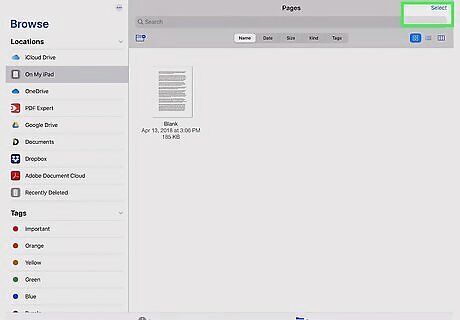
Tap Select. It's in the upper-right corner of the Files app. This displays a circular button next to each file.

Tap the files you want to transfer. This displays a checkmark icon next to the files you select.
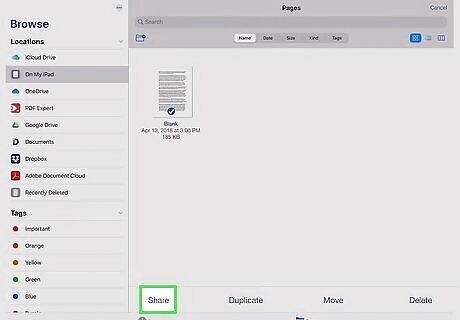
Tap Share. It's in the lower-left corner of the Files app. This displays the Share menu.
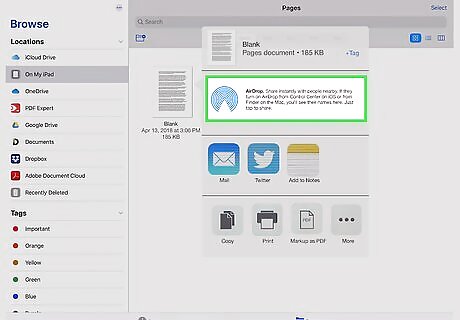
Tap the AirDrop icon in the share menu. The icon has several concentric circles with an upside-down V at the bottom. This displays contacts that are available through AirDrop in the menu. For a contact to be available through AirDrop, they must be signed in to their Apple ID on their device. Both devices must be on the same Wi-Fi network and have Bluetooth turned on. AirDrop must be discoverable by "Contacts" or "Everyone" on the receiving device. Transferring files via AirDrop may not be available on some older iPhone, iPad, iMac, or Macbook models.
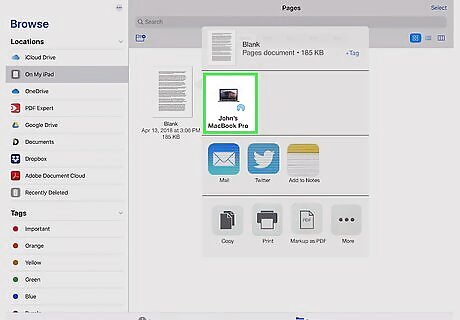
Tap a contact in the AirDrop section. The AirDrop section is the second section in the Share menu. It displays the profile image and devices for all contacts (including yourself) available through AirDrop. This starts sending the files to your Mac. Your Mac will make a sound when the file transfer is complete. You can find the files in the "Downloads" folder in the Finder on your Mac.

Open an Email app on your iPhone or iPad. Tap the email app you use to send an email on your iPhone or iPad. If you use Apple Mail, tap the blue icon with a white envelope at the bottom of the screen. If you use Gmail or Outlook, tap the app icon on your home screen. This is another easy solution that you can use to transfer files between your iPad and Windows 10 computer.

Tap the compose icon. This is the icon you tap to create a new email message. In Apple Mail and Outlook, the icon resembles a pencil and paper at the top of the screen. On Gmail, it's the icon with the plus sign (+) in the lower-left corner.
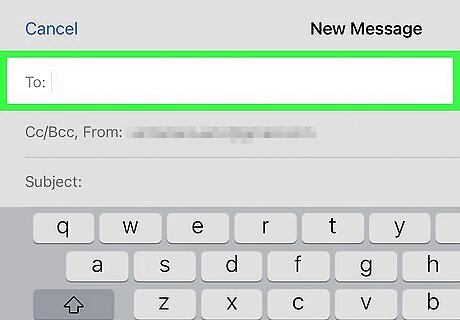
Type your email address in the recipient line. This is usually the line that says "To:" or "Recipient" in the email composition form.

Type a subject for the email. Use the subject line to type a subject for the email. This can be the name of the files or just "Files."
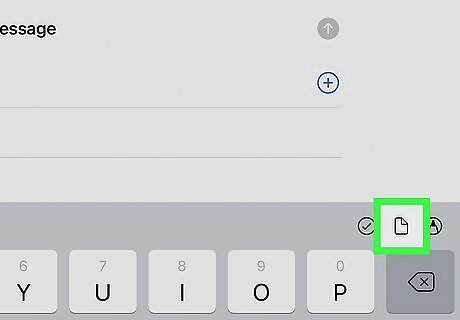
Tap the attachment icon. This is usually an icon that resembles a paperclip. It's at the top of the screen or in the upper-right corner of the on-screen keyboard.
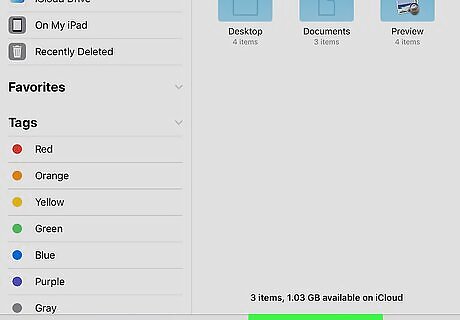
Tap Browse (if available). It's the second tab at the bottom of the screen. If you are using Gmail, just tap the file you want to send in the list of files.

Tap On My iPad. It's next to an icon that resembles an iPad in the menu to the left.
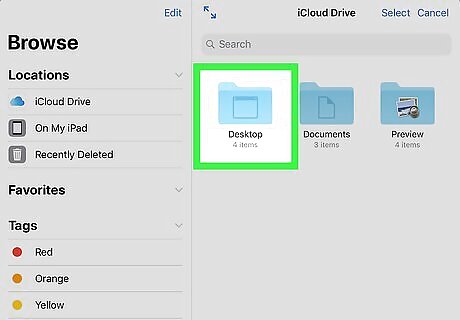
Tap the program that has files you want to transfer. Program files in the Files app are organized by app. Tap the app folder that corresponds to the files you want to transfer. This displays all the files for that app.
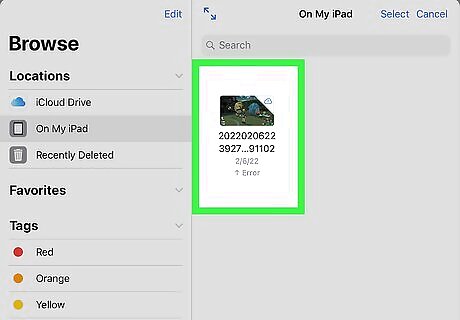
Tap the file you want to transfer. This uploads the file as an email attachment Some email services may limit the size of the file you can upload. If you are unable to attach a file, it may be too big.

Tap the Send icon. In Apple Mail, the button says Send in the upper-right corner. In Outlook and Gmail, the icon resembles a paper airplane in the upper-right corner.
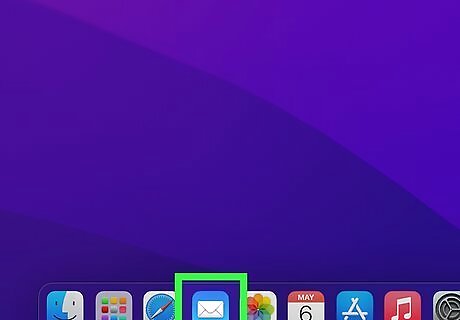
Open your email app on your Mac. If you are using Outlook or Apple Mail, tap the icon in the Applications folder in the Finder or the Dock. If you are using Gmail, navigate to https://mail.google.com in a web browser. If you are not signed in to your email automatically, type your email address and password to sign in.
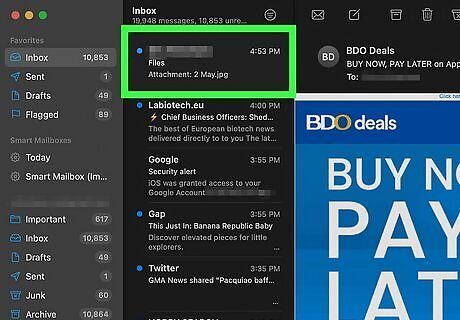
Open the email that you sent to yourself. Look for an email with the subject you typed and click it to open it.
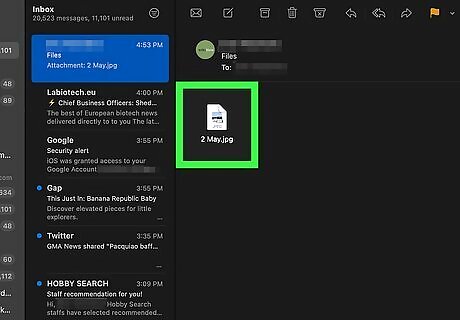
Double-click the attachments to download them. Attachments are usually listed at the bottom of the email. By default, you can find your Downloads folder in the Finder.
Microsoft OneDrive

Go to https://onedrive.com/ in your browser. This will open your Microsoft OneDrive main page if logged into your Microsoft account. If you aren't logged into your Microsoft account, enter your email address and password before proceeding.
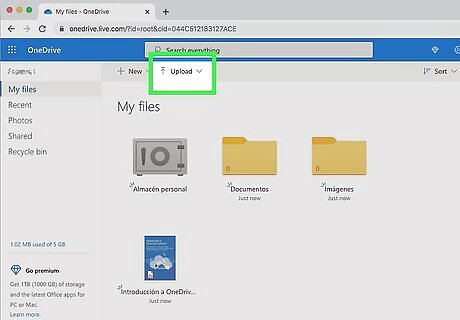
Click Upload. It's at the top of the page. A drop-down menu will appear. If you'd like to save the file in a specific folder, first click the folder in which you'd like to save it.
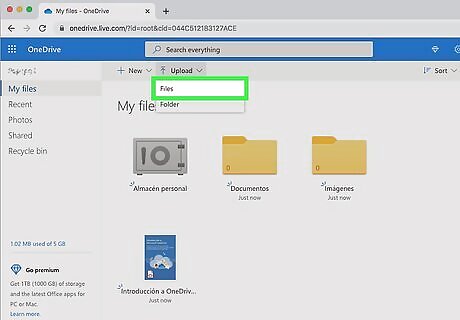
Click Files. This option is in the drop-down menu. Doing so will open a File Explorer (Windows) or Finder (Mac) window. If you want to upload a folder full of files, click Folder here instead.
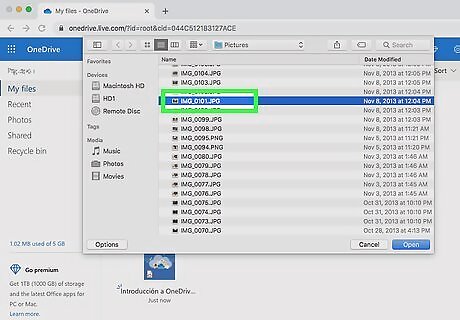
Select files. Click a file that you want to upload to OneDrive or hold down Ctrl (Windows) or ⌘ Command (Mac) while clicking individual files to select them independently. You can also select all files in a given location by clicking one file and then pressing Ctrl+A (Windows) or ⌘ Command+A (Mac). If you want to upload a folder, click the one you want to upload instead.
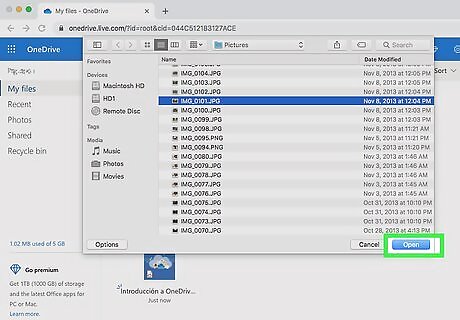
Click Open. It's in the bottom-right corner of the window. This will prompt your files to begin uploading to OneDrive.
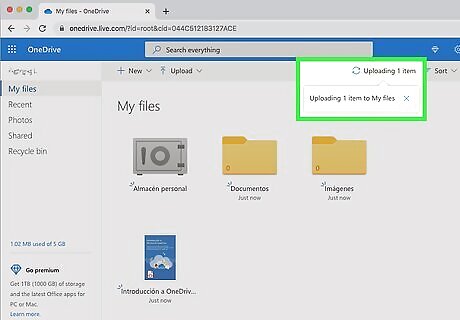
Wait for the files to finish uploading. The time needed for this step will vary depending on your files' collective size. Once the upload is complete, you can proceed.
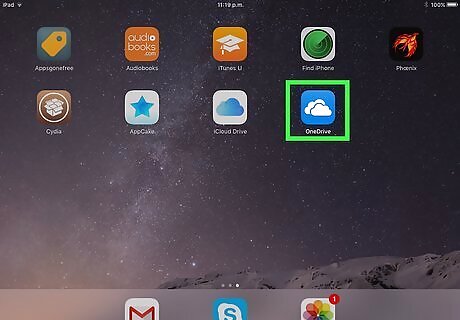
Open OneDrive iPhone OneDrive on your iPad. Tap the OneDrive app icon, which resembles two white clouds on a blue background. This will open your OneDrive main page if you're logged in. Again, if you aren't logged in, enter your email address and password.
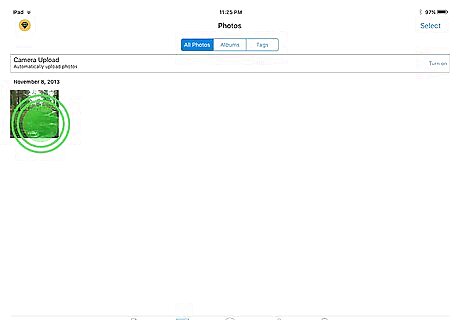
Tap and hold a file to select it, then tap any other files/folders that you want to download onto your iPad to select. This selects the file. To select multiple files, tap and hold the first file, then tap each other file that you want to select.
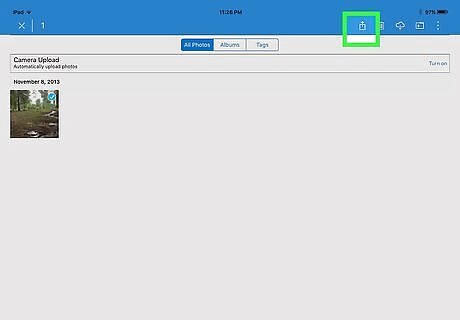
Tap the "Share" icon iPhone Share. It's the upward-facing arrow icon on the upper-left side of the screen. A menu will appear.
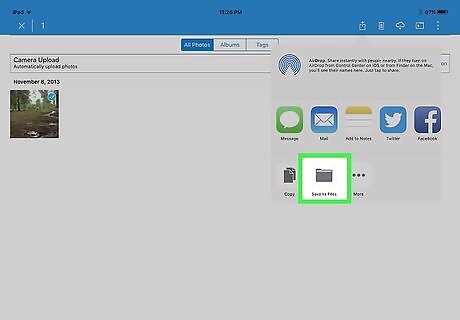
Tap Save to Files. This folder-shaped icon is in the menu at the bottom of the screen.
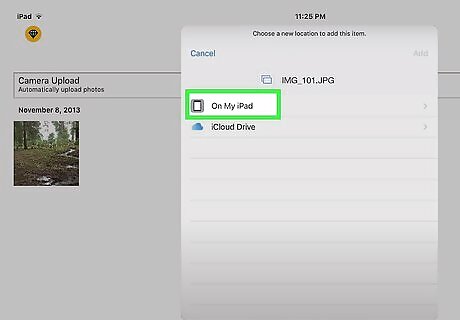
Tap On my iPad. This displays a list of folders on your iPad.
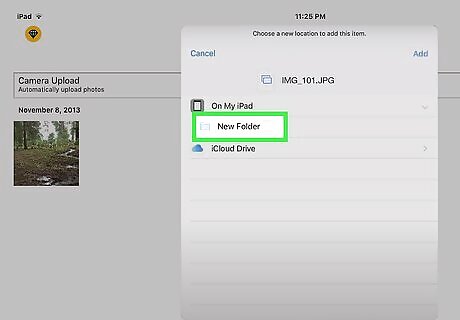
Tap a folder you want to save the files to. Below the "On My iPad" heading, tap a folder (e.g., Pages) to select it as the folder to which you want to save your OneDrive file.
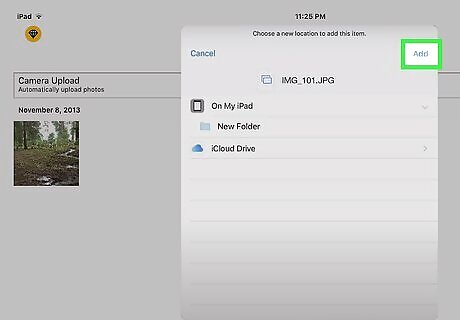
Tap Add. It's in the top-right corner of the screen. You can now open the file on your iPad even if you're not connected to the Internet.
Google Drive
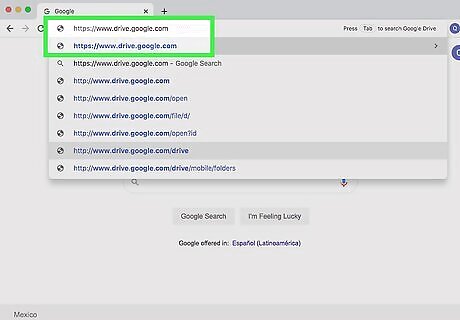
Go to https://www.drive.google.com/ in your browser. This will open your Google Drive account if you're logged into your Google account. If you aren't logged into Google Drive, click the blue Go to Google Drive button if available, then enter your email address and password before continuing.
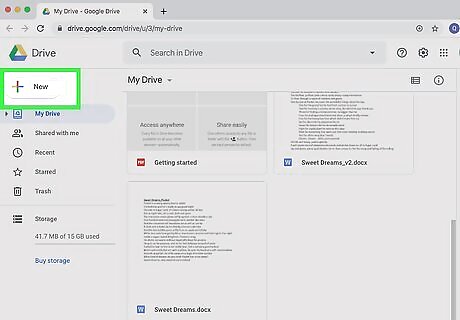
Click NEW. It's a blue button in the upper-left corner of the window. This will prompt a drop-down menu. If you'd like to save the file in a specific folder, first click the folder in which you'd like to save it.
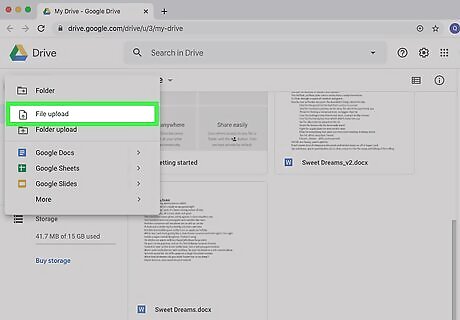
Click File upload. This option is in the drop-down menu.
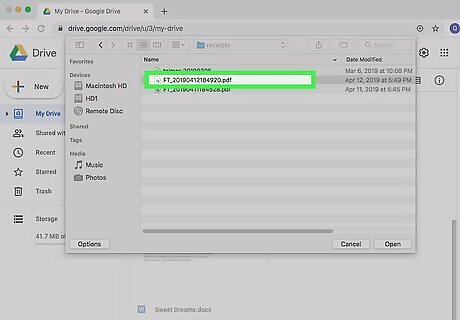
Click a file that you want to upload to Google Drive. To select multiple files, hold down Ctrl (Windows) or ⌘ Command (Mac) and click the files you want to upload. You can also select all files in a given location by clicking one file and then pressing Ctrl+A (Windows) or ⌘ Command+A (Mac).
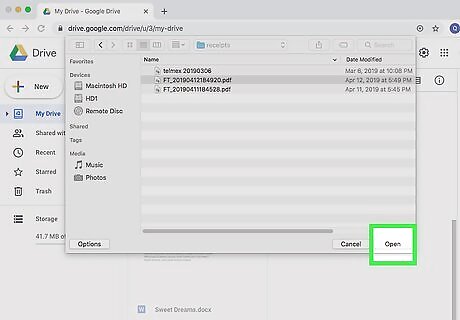
Click Open. It's in the bottom-right corner of the window. Doing so will prompt your files to begin uploading to Google Drive.
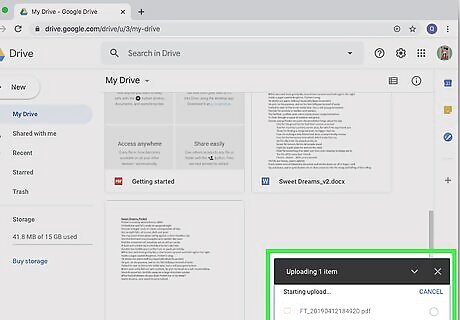
Wait for your files to upload. The time needed to complete this step will vary depending on how large your files are. Once the upload is complete, you can proceed.
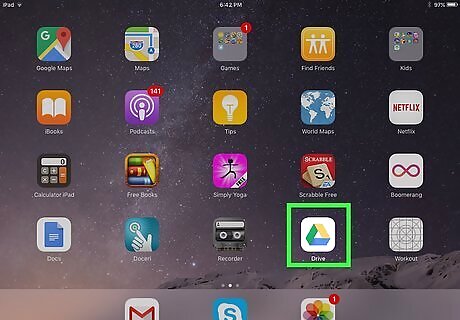
Tap the Google Drive app icon. It resembles a green, blue, and yellow triangle on a white background. This will open the Google Drive main page if you're logged in. Again, if you aren't logged into Google Drive, enter the email address and password for the account on which you uploaded the files.
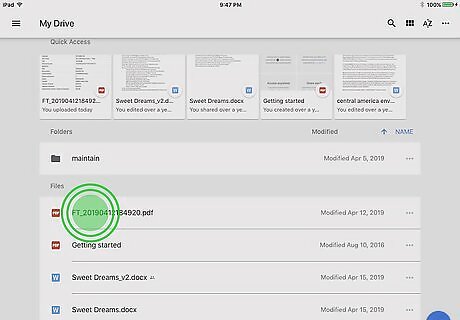
Tap and hold a file to select it. This selects the file. To select multiple files, tap and hold the first file, then tap each other file that you want to select.
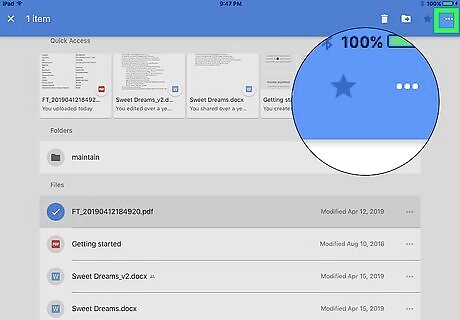
Tap ⋯. It's the icon with three dots next to each file in the Google Drive folder.
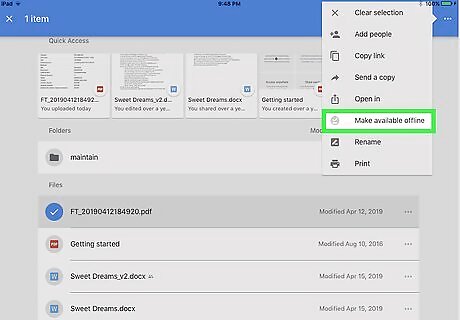
Tap Make available offline. This option is in the pop-up menu. Doing so means you can open the files within Google Drive even when your iPad isn't connected to the Internet. There is a Google Drive option in the Files app, but you can't download multiple files from Google Drive into your Files app like you can with other cloud storage apps.
















Comments
0 comment